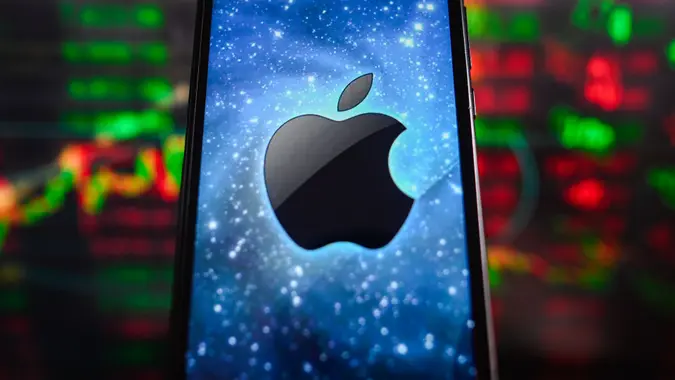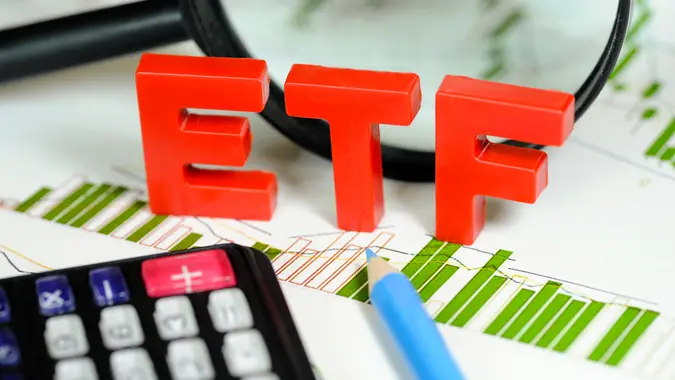What Exactly Is an ETF? Understanding Exchange-Traded Funds

Commitment to Our Readers
GOBankingRates' editorial team is committed to bringing you unbiased reviews and information. We use data-driven methodologies to evaluate financial products and services - our reviews and ratings are not influenced by advertisers. You can read more about our editorial guidelines and our products and services review methodology.

20 Years
Helping You Live Richer

Reviewed
by Experts

Trusted by
Millions of Readers
An ETF is a collection of securities packaged and sold in a single basket, or fund. Most ETFs are passively managed and designed to mirror the performance of indices, such as the S&P 500. The funds may include multiple different sectors like manufacturing, tech, clean energy or even strategies like dividend investing.
ETFs are easy to buy and sell and they can be affordable. They can expose you to a variety of securities that allow you to diversify with the purchase of a single share.
Since they don’t involve picking stocks, you can build a complete portfolio with just one ETF, making it a beginner-friendly investment strategy.
How Do ETFs Work?
ETFs, or exchange-traded funds, work by pooling money from multiple investors to create a diversified portfolio of assets, which can include stocks, bonds, commodities, or other investments. This pooled structure allows investors to own a share of the entire portfolio rather than individual assets, providing exposure to a broad range of investments in a single purchase.
ETFs can include stocks, bonds or a blend of investment types, and they can be made up of just a few securities or many. Although most ETFs focus on stocks or bonds, they can also include other assets, like commodities (i.e., gold) and real estate. They can’t include anything the SEC doesn’t regulate. Until recently, there were no cryptocurrency ETFs. Although the SEC now allows some crypto ETFs, there are some limitations, like fine art ETFs.
How Are ETFs Managed?
ETFs aim to track the performance of a specific index, sector, or investment strategy. Once created, ETF shares are traded on stock exchanges just like individual stocks, offering flexibility, liquidity, and transparency to investors.
Unlike actively managed portfolios, ETFs don’t have managers who frequently buy and sell stocks or other securities in an attempt to maximize performance. Instead, your portfolio is monitored and the manager will only buy and sell stocks if the fund isn’t on track with the index it’s mirroring.
An S&P 500 index manager, for example, won’t pick and choose individual stocks in an effort to beat the market. Rather, they will simply buy or sell stocks for the portfolio when the index itself adds or removes companies from the index.
Types of ETFs
The following are the most common types of ETFs, but each category is broad and can include many subcategories.
- Index ETFs: Track a specific index of the market, like the S&P 500
- Fixed-income ETFs: Invest solely in bonds and other fixed-income products like preferred stocks
- Commodity ETFs: Invest in commodities, like gold
- International ETFs: Invest in foreign markets
- Currency ETFs: Track specific currencies
- Inverse ETFs: Performs opposite the index it tracks — increasing in value when the index decreases and vice versa
- Leveraged ETFs: Rebalanced daily to reach a leverage goal
- Actively managed ETFs: A fund manager makes decisions on the fund’s portfolio
- Exchange-traded notes: debt securities issued by financial institutions
- Bitcoin ETFs: Recently approved by regulators, these ETFs invest in the cryptocurrency Bitcoin
- ESG ETFs: Invest in stocks that score highly on environmental, social and governance metrics
- Passively Managed ETFs: Most ETFs are passively managed, meaning they simply track an underlying index
- Industry/Sector ETFs: Track stocks in a particularly industry or sector only, making them not diversified
- Dividend ETFs: Invest in stocks that pay higher-than-average dividends
- Stock ETFs: Some ETFs can be actively managed, buying and selling stocks according to the fund’s investment objectives
- Thematic ETFs: Follow certain investment themes or indexes, such as “the future of finance” or “transition to a low-carbon economy”
How Are ETFs Different From Mutual Funds?
ETFs are similar in many ways to mutual funds, but there are some important differences. The most important one is that the ETFs trade on an exchange and can be bought and sold at any time that the stock market is open. Traditional mutual funds, on the other hand, must be bought directly from a mutual fund company – although they are accessible through a number of different brokers – and they are only priced once per day, after the market closes. Either way, you’ll need a brokerage account to buy or sell shares.
Although there are exceptions, traditional mutual funds are actively managed, whereas ETFs are passively managed.
Benefits of ETFs
- Immediate exposure to many securities in one purchase.
- ETFs offer diversified investing, which can make your investments less risky
- Low costs compared to traditional mutual funds.
- Ease and accessibility — you buy and sell shares in real time, just like stocks.
- Tax advantages over standard mutual funds and other common investments.
Risks of Investing in ETFs
- ETFs tend to have lower dividend yields, although some track dividend stocks specifically.
- In some cases, as with some foreign stocks, ETFs are limited only to large-cap stocks, which makes it harder to diversify with small- and mid-caps.
- Even ETFs with dirt-cheap expense ratios charge at least a nominal fee. Individual stocks, on the other hand, do not.
Good To Know
When people talk about the “stock market” as up or down, they’re usually referring to the S&P 500 index, which tracks the 500 largest U.S.-based corporations. Several funds, like Vanguard 500 Index Fund ETF (VOO), track the S&P. That means you can invest in the top 500 companies with the purchase of a single share of a single fund — which happens to be among the cheapest ETFs on the market.
How To Buy and Sell ETFs
Buying or selling an ETF is just like buying or selling a stock, as they both trade on public exchanges. But first, you’ll need to have a brokerage account. If you don’t yet have one open, you’ll need to provide personal and financial information, such as the following:
- Name
- Address
- Date of birth
- Social Security number
- Bank information to fund your account
As each financial institution is different, you may be asked for additional information to open your account.
Once you have an account, you can buy or sell any ETF you like. Simply select the ETF(s) you want to purchase and either inform your broker or enter the trade yourself online. If you plan on trading ETFs frequently or are investing small dollar amounts, it’s imperative that you choose a zero-commission broker. Fortunately, most firms have now adopted this zero-commission structure for both stock and ETF trades.
How To Buy and Sell ETFs
Buying or selling an ETF is just like buying or selling a stock, as they both trade on public exchanges. But first, you’ll need to have a brokerage account. If you don’t yet have one open, you’ll need to provide personal and financial information, such as the following:
- Name
- Address
- Date of birth
- Social Security number
- Bank information to fund your account
As each financial institution is different, you may be asked for additional information to open your account.
Once you have an account, you can buy or sell any ETF you like. Simply select the ETF(s) you want to purchase and either inform your broker or enter the trade yourself online. If you plan on trading ETFs frequently or are investing small dollar amounts, it’s imperative that you choose a zero-commission broker. Fortunately, most firms have now adopted this zero-commission structure for both stock and ETF trades.
Even though ETFs generally comprise multiple securities, you should analyze each fund with the same level of scrutiny as you would for individual stocks. As most ETFs track indexes, it’s relatively easy to find out what individual securities are in each fund. Use this information to ensure that the ETFs you buy match your investment objectives and your risk tolerance.
Popular ETFs to Consider
If you’re new to the game, these are some of the best-known ETFs on the market. They might be a good place to start.
SPDR S&P 500 ETF Trust (SPY): The first and most famous of all the S&P 500 funds.
- Assets under management: $634.37 billion
- YTD return: 2.27%
- 5-year return: 14.49%
- Expense ratio: 0.09%
- Dividend yield: 1.28%
SPDR Dow Jones Industrial Average ETF Trust (DIA): This ETF tracks the Dow, an index that’s almost as important and widely followed as the S&P 500.
- Assets under management: $39.01 billion
- YTD return: 3.79%
- 5-year return: 11.45%
- Expense ratio: 0.16%
- Dividend yield: 1.74%
iShares Core S&P 500 ETF (IVV): The second-largest S&P 500 ETF tracker.
- Assets under management: $610.21 billion
- YTD return: 0.58%
- 5-year return: 18.97%
- Expense ratio: 0.03%
- Dividend yield: 1.31%
Vanguard S&P 500 ETF (VOO): An S&P 500 ETF tracker from the very popular management firm Vanguard; also, the 3rd-largest ETF in the world.
- Assets under management: $627.88 billion
- YTD return: 2.27%
- 5-year return: 14.49%
- Expense ratio: 0.03%
- Dividend yield: 1.32%
Vanguard Total Stock Market ETF (VTI): This ETF from revered Vanguard tracks every security in the entire stock market in a single investment.
- Assets under management: $479.77 billion
- YTD return: 0.58%
- 5-year return: 18.97%
- Expense ratio: 0.02%
- Dividend yield: 1.36%
Here is the updated information for the specified ETFs as of January 28, 2025:
SPDR S&P 500 ETF Trust (SPY): The first and most famous of all the S&P 500 funds.
- Assets under management: $637.37 billion
- YTD return: 2.27%
- 5-year return: 14.49%
- Expense ratio: 0.09%
- Dividend yield: 1.28%
SPDR Dow Jones Industrial Average ETF Trust (DIA): This ETF tracks the Dow, an index that’s almost as important and widely followed as the S&P 500.
- Assets under management: $39.01 billion
- YTD return: 3.79%
- 5-year return: 11.45%
- Expense ratio: 0.16%
- Dividend yield: 1.74%
iShares Core S&P 500 ETF (IVV): The second-largest S&P 500 ETF tracker.
- Assets under management: $610.21 billion
- YTD return: 0.58%
- 5-year return: 18.97%
- Expense ratio: 0.03%
- Dividend yield: 1.31%
Vanguard S&P 500 ETF (VOO): An S&P 500 ETF tracker from the very popular management firm Vanguard; also, the 3rd-largest ETF in the world.
- Assets under management: $627.88 billion
- YTD return: 2.27%
- 5-year return: 14.49%
- Expense ratio: 0.03%
- Dividend yield: 1.32%
Vanguard Total Stock Market ETF (VTI): This ETF from revered Vanguard tracks every security in the entire stock market in a single investment.
- Assets under management: $479.77 billion
- YTD return: 0.58%
- 5-year return: 18.97%
- Expense ratio: 0.02%
- Dividend yield: 1.36%
Invesco QQQ Trust Series I (QQQ): Often referred to as “the Q’s,” this popular ETF tracks the Nasdaq-100 index, which holds many of the biggest tech names.
- Assets under management: $334.16 billion
- YTD return: 0.58%
- 5-year return: 18.97%
- Expense ratio: 0.20%
- Dividend yield: 0.58%
ETFs are a great way to invest because they offer diversification, low costs, and the convenience of trading like a stock. They can help you build a balanced portfolio without the hassle of picking individual investments. That said, it’s important to be aware of potential risks like market swings and tracking errors, which can affect your returns.
If you’re new to investing, start by defining your goals and understanding how much risk you’re comfortable taking. Look for ETFs that match your needs, whether it’s a broad market fund for general growth or a sector-specific option for targeted exposure. Do your homework–compare expense ratios, past performance, and what the fund actually invests in. A little research goes a long way in choosing the right ETF to help you grow your wealth.
Andrew Lisa and Sean Dennison contributed to the reporting for this article.
Data is accurate as of Jan. 28, 2025 and is subject to change. ETF information was sourced from Yahoo Finance.
Our in-house research team and on-site financial experts work together to create content that’s accurate, impartial, and up to date. We fact-check every single statistic, quote and fact using trusted primary resources to make sure the information we provide is correct. You can learn more about GOBankingRates’ processes and standards in our editorial policy.
- Google Finance. "Google Finance."
- SEC. "Statement on the Approval of Spot Bitcoin Exchange-Traded Products."
- U.S. Securities and Exchange Commission "Investor Bulletin: Exchange-Traded Funds"
- U.S. Securities and Exchange Commission "Mutual Funds and Exchange-Traded Funds (ETFs) – A Guide for Investors"
 Written by
Written by  Edited by
Edited by 
























